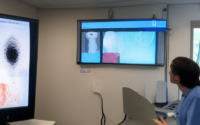Novavax’s updated COVID-19 vaccine offers more choices
Ahn Jae-yong, left, CEO of SK bioscience, receives Novavax’s updated COVID-19 vaccine, Dec. 18. Courtesy of SK bioscience By Baek Byung-yeul SK bioscience began its domestic supply of Novavax’s updated COVID-19 vaccine, which targets the XBB.1.5 variant, Dec. 18, as part of the country’s effort to provide a wider range of vaccine choices in addition to mRNA-based vaccines, according to the vaccine maker, Sunday. SK bioscience exclusively distributes Novavax’s updated vaccine in Korea. The Ministry of Food and Drug Safety granted emergency use authorization on Nov. 29 for the product, its first approval in Asia, and the fourth globally. Its CEO Ahn Jae-yong encouraged vaccinations by receiving the shot at a clinic near company headquarters in Seongnam, Gyeonggi Province, Dec. 18. “As we head into the holiday season in winter, Novavax’s updated COVID-19 vaccine emerges as a new option for national immunization. Vaccination is the easiest way to protect ourselves and our loved ones,” Ahn said. The health authorities and medical experts here expect that the introduction of Novavax’s synthetic antigen-based COVID-19 vaccine, which has strengths in safety, can help boost the sluggish vaccination rate. Vaccination is the most effective way to prevent coronavirus infection and reduce the risk of severe illness and death. According to the government’s data in February, the severe illness rate in those over 80 was reduced from 4 percent to 0.72 percent after vaccination with the updated vaccine, and the mortality rate was reduced from 2.38 percent to 0.41 percent. Given the antibodies generated by the vaccine decrease gradually three months after vaccination, receiving an updated vaccine can become a good choice for maintaining one’s health. Currently, there are three types of updated COVID-19 vaccines available in Korea — two types of mRNA vaccines and one type of synthetic antigen vaccine. The experts added that it is desirable to get the COVID-19 vaccine not only for high-priority groups such as those over 65, immunocompromised individuals like cancer patients and workers in infection-prone facilities, but also for younger people. Although the severity of infection is lower in younger people, they have the potential to transmit the virus to their families. In fact, it is known that if a COVID-19 infection occurs within a family, the risk of secondary transmission is as high as 45 percent.
Link to the original story: https://koreatimes.co.kr/www/nation/2023/12/779_365687.html?utm_source=fl

